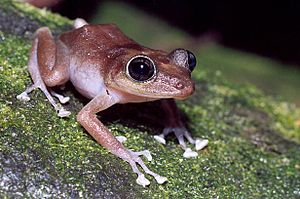Puerto Rican rock frog facts for kids
Quick facts for kids Puerto Rican rock frog |
|
|---|---|
 |
|
| Female Puerto Rican rock frog | |
| Conservation status | |
| Scientific classification | |
| Genus: |
Eleutherodactylus
|
| Species: |
cooki
|
 |
|
| Known habitat area, east Puerto Rico | |
The Puerto Rican rock frog, also known as the rock coqui or coquí guajón, is a special type of frog found only in Puerto Rico. Its scientific name is Eleutherodactylus cooki. This unique tropical frog lives mostly in cracks and small caves within the Cuchilla de Panduras mountains in southeastern Puerto Rico. The local name guajón comes from its home, guajonales, which are caves made by huge rocks.
Even though this frog is a symbol of Puerto Rico, it is a threatened species. Of the 17 types of coqui frogs, three are thought to be gone forever, and the others are becoming rare. The Puerto Rican rock frog lives in a very small area. Its numbers are decreasing because of things like cutting down forests, building new farms and towns, and creating new roads. Some people even call it the "demon of Puerto Rico" (demonio de Puerto Rico in Spanish) because of its strange call and ghostly look. An American scientist named Chapman Grant first described this frog in 1932.
Contents
What Does the Rock Frog Look Like?
Female Puerto Rican rock frogs are a bit bigger than males. Females can grow to about 2 inches (51 mm) long, while males are around 1.7 inches (43 mm). These frogs are solid brown with whitish bellies. They have large eyes with white rims, which makes them look a bit like ghosts.
Some males and even some females might have yellow throats and bellies. This frog is the only Eleutherodactylus species where males and females look different in color and size. This difference is called sexual dimorphism. The rock frog has large, flat discs on its feet, which help it grip rocks. It also has a unique, low, musical voice that sounds different from any other coqui frog in Puerto Rico.
Where Does the Rock Frog Live?
This special frog lives only in the southeastern part of Puerto Rico. You can find it in the Cuchilla de Panduras mountain range, near towns like Maunabo, San Lorenzo, and Yabucoa. It also lives in areas around Patillas, Humacao, and Las Piedras.
The Puerto Rican rock frog lives at low and medium heights, from about 18 to 1,183 feet (5 to 361 meters) above sea level. They make their homes in caves formed by huge granite rocks, which are called guajonales. They can also be found near streams that have many rocks, even if there are no cave systems. Scientists believe this frog's home is limited by where these specific rock formations are found.
Why Are Rock Frog Numbers Declining?
It is hard to study the Puerto Rican rock frog because it lives in hidden and complex places. This means scientists do not have much detailed information about how many frogs there are or how healthy their groups are. This frog lives in a very small area and needs a specific type of home.
Species that live in small areas or need special habitats are more likely to be harmed by human activities. Most of the known groups of these frogs live on private land, where more and more building is happening. The Puerto Rican rock frog is threatened by cutting down forests, new construction, pollution from farm chemicals, and trash being dumped in caves. Fires can also harm their homes. Since this frog needs very specific conditions to live, big changes to its environment can cause its numbers to drop.
Protecting the Rock Frog
The Puerto Rican rock frog was officially listed as a threatened species on June 11, 1997. This happened because it lives in a small area, needs a special home, and its home is being threatened. The US Fish and Wildlife Service decided it needed protection under the Endangered Species Act of 1973.
In 2003, a group called the Center for Biological Diversity took legal action to make sure the frog's important habitat was protected. They also wanted a plan to help the species recover. As a result, a recovery plan was created in 2004, and in 2007, about 260 acres (1.05 km²) in Puerto Rico were set aside as critical habitat for the frog. The Puerto Rico Department of Natural and Environmental Resources also lists this frog as vulnerable and protects it with local laws.
See also
 In Spanish: Coquí guajón para niños
In Spanish: Coquí guajón para niños


